On this day in history, two masters of early ocean exploration returned to their prospective homes—Vasco da Gama 525 years ago to Lisbon, and Thomas Cavendish 436 years ago to Plymouth. The former had chartered the first European course to India via the Cape of Good Hope, while the latter completed the world’s first intentional circumnavigation. As it happened, Cavendish’s trip also saw the capture of the Santa Anna, the largest Spanish treasure ship ever to fall prey to English privateers. READ more about these accomplishments in seafaring… (1499, 1588)
Obviously when Vasco da Gama traveled in India and back, it rang the starting bell for the oriental chapter of the age of imperialist exploitation of the Asian continent, which resulted in untold suffering and shouldn’t really be celebrated in this history column.
However, imperialism was inevitable, and the route to India would have, without doubt, been discovered regardless. Instead, da Gama’s voyage is remembered here merely as a testament to the incredible drive to explore in our species, as the voyage was long, treacherous, entailed dealing with unknown shores and tides, pirates, powerful empires the Portuguese had never met, and so many more challenges that da Gama and his men had to overcome.
Cavendish, by contrast, was looking to complete a circumnavigation in emulation of that most famous English captain, Sir Francis Drake, who also raided the Spanish treasure fleets along his route. Rather than chart a course around Africa, Cavendish and his three ships sailed around West Africa and struck out across the Atlantic. He avoided crossing Cape Horn by navigating over 100 inlets and channels that formed the broken land of Tierra del Fuego on the fortune that he captured a Spanish pilot who knew those waters well.
Before crossing the Pacific, the dastardly Cavendish embarked on nearly 10 months of raiding and piracy along the western coast of South America, capturing the Santa Anna during the process before a largely peaceful passage across Oceania, the West Indies, the Indian Ocean, and back to England.
Cavendish at the age of twenty-eight became the second Englishmen to circumnavigate the globe. Desire was only the third ship to circumnavigate the globe after the Victoria of Ferdinand Magellan (journey completed by Juan Sebastián Elcano) and the Golden Hind of Francis Drake.
MORE Good News on this Day:
- 67 years ago, Elvis Presley appeared on The Ed Sullivan Show for the first time (1956)
- The first U.S. civil rights bill was signed into law by US President Dwight Eisenhower (1957)
- British Ambassador Geoffrey Jackson was freed 8 months after capture by guerrillas in Uruguay (1971)
- In Kentucky’s Mammoth Cave National Park, a Cave Research Foundation exploration and mapping team discovered a link between the Mammoth and Flint Ridge cave systems, making it the longest-known cave passageway in the world (1972)
- Tajikistan gained Independence from USSR (1991)
- The Palestine Liberation Organization agreed to recognize Israel’s right to exist, and Israel returns mutual recognition for the PLO as the official representative of the Palestinian people (1993)
- The Irish Republican Army‘s political arm, Sinn Fein, formally renounced violence and took a seat at the table with British and Irish leaders to plan a negotiated settlement to end Northern Ireland’s civil unrest—seven 7 later, that’s exactly what happened (1997)
188 years ago today, Ralph Waldo Emerson published his famous essay Nature, in which he attempts to lay out the case for transcendentalism. His chief argument is that god and spirituality are suffused in nature, but that in everyday life, man lacks the ability to perceive it as a whole because we are distracted by concerns of survival. Henry David Thoreau had read Nature as a senior at Harvard College and took it to heart. It eventually became an essential influence for Thoreau’s later writings, including his seminal Walden. In fact, Thoreau’s cabin existed on land that Emerson owned.

In the essay, Emerson explains that to experience the wholeness with nature for which we are naturally suited, we must be separate from the flaws and distractions imposed on us by society. Emerson believed that solitude is the single mechanism through which we can be fully engaged in the world of nature, writing “To go into solitude, a man needs to retire as much from his chamber as from society. I am not solitary whilst I read and write, though nobody is with me. But if a man would be alone, let him look at the stars.”
When a person experiences true solitude, in nature, it “take[s] him away”. Society, he says, destroys wholeness, whereas “Nature, in its ministry to man, is not only the material, but is also the process and the result. All the parts incessantly work into each other’s hands for the profit of man. The wind sows the seed; the sun evaporates the sea; the wind blows the vapor to the field; the ice, on the other side of the planet, condenses rain on this; the rain feeds the plant; the plant feeds the animal; and thus the endless circulations of the divine charity nourish man.”
Emerson used spirituality as a major theme in the essay, and referred to nature as the “Universal Being”; he believed that there was a spiritual sense of the natural world around him.
Emerson believed in reimagining the divine as something large and visible, which he referred to as nature; such an idea is known as transcendentalism, in which one perceives a new God and a new body, and becomes one with his or her surroundings. Emerson confidently exemplifies transcendentalism, stating, “From the earth, as a shore, I look out into that silent sea. I seem to partake its rapid transformations: the active enchantment reaches my dust, and I dilate and conspire with the morning wind”, postulating that humans and wind are one. (1836)
232 years ago, America’s capital was named after her beloved first president, the loyal servant and general who led a motley army against the British to gain independence: George Washington. Washington, D.C. became famous worldwide for its impressive monuments laid out around a grand mall, with free museums lining every side of the plaza.
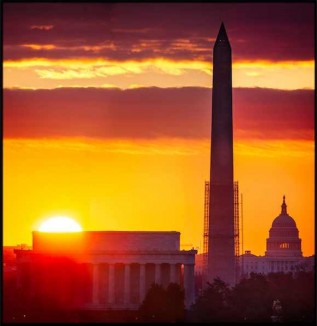

Buildings have been prohibited from rising any higher than those monuments, which preserves the historical feeling and photographic vistas in all direction inside the federal city.
Also 15 years earlier on the same day, the Continental Congress officially named its new nation the United States. (1791)
On this day in 1890, Colonel Sanders of KFC fame was born.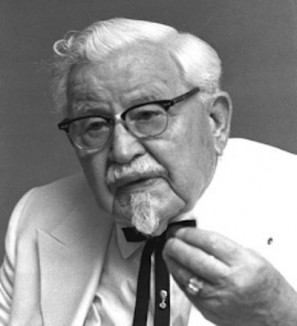
Harland David Sanders began selling fried chicken from his roadside restaurant in North Corbin, Kentucky, during the Great Depression. Commissioned as a Kentucky Colonel by the governor, he had a “Secret Recipe” for frying chicken in a pressure fryer, which cut cooking times. He recognized the potential of the restaurant franchising concept, and, with a product that evoked the imagery of Southern hospitality, the first KFC franchise opened in Utah in 1952. At age 65, Sanders had little money so decided to search for new franchisees, often sleeping in the back of his car as he traveled the country. Sanders later used his stock holdings to create the Colonel Harland Sanders Trust and Charitable Organization, which used the proceeds to aid charities and fund scholarships.
23 years ago today, Band of Brothers premiered and demonstrated the power of the miniseries to tell a story better than a motion picture. Produced by Spielberg with Tom Hanks as his advisor, it premiered on HBO and went on to win the Emmy and Golden Globe for best miniseries. The story was based on the 1992 non-fiction book of the same name written by Steven E. Ambrose.
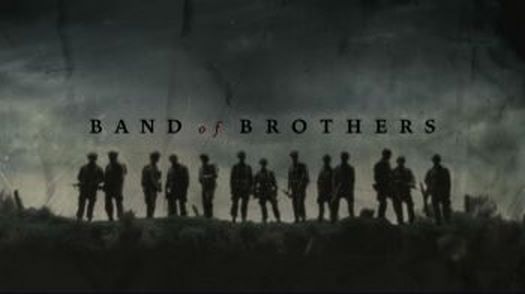
The series dramatizes the history of “Easy” Company, 2nd Battalion, 506th Parachute Infantry Regiment, of the 101st Airborne Division, from jump training in the United States through its participation in major actions in Europe, up until Japan’s capitulation and the end of World War II. The events are based on Ambrose’s research and recorded interviews with Easy Company veterans.
Historical accuracy was, since the book was based on a collection of memoires and interviews with actual soldiers, paramount to be perceived success of the miniseries. Hanks, himself a lover of all things history, said at the time “we’ve made history fit onto our screens.”
“We had to condense down a vast number of characters, fold other people’s experiences into 10 or 15 people, have people saying and doing things others said or did. We had people take off their helmets to identify them, when they would never have done so in combat. But I still think it is three or four times more accurate than most films like this.”
As a final accuracy check, as many veterans from “Easy Company” as cared to do so were given a final screening of the series to address any grievous liberties. (2001)
Happy 64th Birthday to actor and film producer Hugh Grant. The befuddled rom-com movie charmer first achieved international success in 1994 for his appearance in Four Weddings and a Funeral, for which he won a Golden Globe and BAFTA for Best Actor.

Other notable Grant films to check out: Notting Hill, Mickey Blue Eyes, Bridget Jones’s Diary, About a Boy, and period pieces such as The Remains of the Day and Sense and Sensibility. Most recently, he won BAFTA and Golden Globe nominations for Florence Foster Jenkins in 2016 and A Very English Scandal in 2018.
He is married to a “great wife”, Anna Eberstein, and he has thought of running for office, but, so far, chooses to campaign for other candidates. WATCH a rundown of his ‘Top 10’ films… (1960)
83 years ago today, the soulful singer Otis Redding was born. At 15, he quit school to work in music and support his parents in Macon, Georgia. Three days before his tragic death in a plane crash at age 26, he recorded the iconic song, (Sittin’ on) The Dock of the Bay,’ which shot to #1 on the charts. The year prior, he released ‘Try a Little Tenderness,’ the song that epitomizes his signature sound. 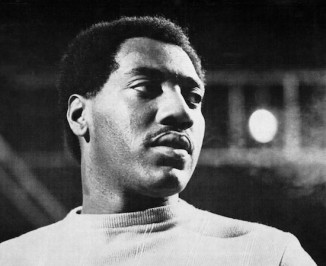
He also wrote ‘Respect,’ and had a major influence on Aretha Franklin. Artists from many genres have named Redding as a musical influence, like the Rolling Stones. George Harrison called “Respect” an inspiration for “Drive My Car”, and others have covered or mixed his songs, notably Kanye West and Jay-Z in their Grammy-winning “Otis”.
His bandmate and co-writer on Dock of the Bay, Steve Cropper, said, “I don’t think anybody I’ve ever worked with had the impact that Otis Redding did. He was the only artist on the label that everybody–all the musicians, all the secretaries, all the employees–looked forward to seeing at the studio. Otis was your best friend when he was with you and he made you feel wanted, needed and all that.” (1941)
185 years ago today, the superstar British scientist Sir John Herschel, who first used the word ‘photography’, took the first photograph on a glass plate. The ‘negative’ photograph (a term he also coined) used a layer of silver chloride to react with light—and it still survives today. The image, now faded and kept in The Science Museum in London, shows the structure used to support a 40-ft telescope owned by his astronomer father in Slough, England.
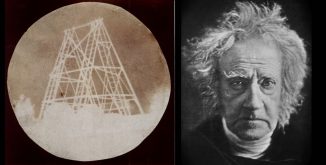
Herschel’s glass-plate method was ideal for photographing the skies and it was used well into the 1990s. The astronomer, mathematician, chemist, inventor, musician, and artist, also named seven moons of Saturn and four Uranus moons. During his work with color and light waves a few years later, Herschel invented the ‘Cyanotype’ printing method, isolating ferric salts through a photochemical process that produces the cyan—Prussian blue—color for use in printing images, thus inventing blueprints. WATCH a video about Herschel’s influence on Darwin—and mentorship of a great female photographer… (1839)
SHARE The Milestones, Memories, and Movies…